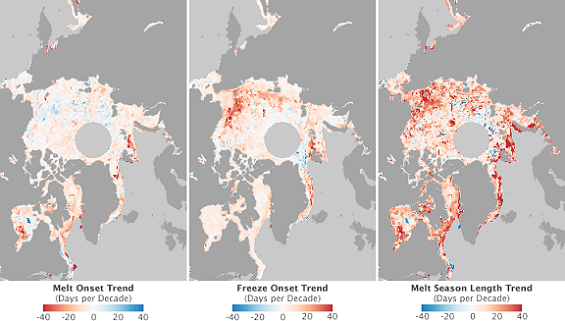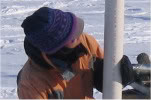Newly released images from NASA and the National Snow and Ice Data Center show that the Arctic’s melt season has lengthened significantly over the past few decades.
The melting season—i.e. the length of time in which continuous melting occurs—has increased on average by 6.4 days for every decade between 1979 and 2007. Around the lower-latitude edges of the ice pack, however, this lengthening was far above the average.
According to NASA, researchers collect this data by using satellite observations of the microwave energy radiated from the Arctic ice, which reveals the appearance of even small amounts of melt water.

According to the press release: “This trio of images shows changes between 1979 and 2007 in the average date of melt onset in the spring (left), the first autumn freeze (center), and the total average increase in the length of the Arctic sea ice melt season. The color scales show the trends in days per decade. Red indicates trends consistent with warming: earlier melt onset, later freezes, and longer total melt season. White indicates little or no change.” Image courtesy of NASA.

According to the press release: “The graph […] illustrates how the length of the melt season varies significantly from year to year, but the long-term trend is clear.” Image courtesy of NASA.
Related articles
b>Sea levels set to rise more than expected due to ‘deeply surprising’ Greenland melt
(12/14/2009) A new study by the Arctic Monitoring and Assessment Program estimates that the sea will rise by 0.5 to 1.5 meters by 2100, threatening coastal cities and flooding island nations. This is double the predicted rise estimated by the UN’s Intergovernmental Panel on climate Change (IPCC) in 2007, which did not incorporate sea level rise due to the melting of Greenland and Antarctica’s ice sheets.
Arctic lake undergoing unprecedented changes due to warming

(10/19/2009) The Arctic should be growing cooler, but a new sediment core taken from an Arctic lake reveals that the lake’s ecology and chemistry has been transformed by unnatural warming beginning in the 1950s. The sediment core proves that changes happening in the lake during the Twentieth Century are unprecedented over the past 200,000 years. Headed by University of Colorado scientist Yarrow Axelford, the study retrieved the sediment core from the bottom of a thirty foot deep lake on Baffin Island. Importantly the sediment core goes back 80,000 years further than any other core retrieved from the Greenland ice sheet, providing researchers with the longest timescale yet of changes in the Arctic climate.
b>Satellite lasers show melting of Greenland, Antarctic worse than expected
(09/23/2009) Resaerchers examining 43 million satellite measurements of Antarctica’s thinning ice sheets and 7 million of Greenland’s, show that the ice is melting faster than expected. Published in Nature the research is the most comprehensive picture to date of the melting glaciers, allowing scientists to better predict how sea levels may rise.